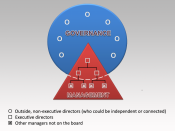"Despite its alleged flaws, the U.S. corporate governance system has performed very well, both on an absolute basis and relative to other countries" (Chew & Gillan, p.16, 2005). The concepts of corporate governance are essential for any firm operating into today's business environment, particularly with Sarbanes-Oxley. Corporations must at times reinvent its business model as it relates to its managerial oversight and accountability. The overall goal in each of the companies that will be addressed in the corresponding benchmarking analysis is that each company has faced corporate compliance issues and necessary measures have been successfully implemented to ensure greater shareholder wealth and managerial accountability and transparency. In addition, this paper will draw comparisons in strategy as well as address contrasting courses of action taken.
Eastman Kodak by Jeffrey Mapes"Corporate governance takes into consideration company stakeholders as governmental participants, the principle participants being shareholders, company management, and the board of directors" (Introduction to corporate governance, p.1,
2008). Eastman Kodak founded in 1888, known for not only photography but as its business model has continued to evolve relevant to changing technologies and consumer demand additionally develops commercial and scientific applications (History of Kodak, 2008). Long-term performance initiatives and diversification was not always successful as the firm's business model deteriorated significantly over the 1990's, specifically as early as 1992 the firm ratio of debt to capital was nearly 60% and a debt souring to $10.3 billion (Rigdon & Star, 1993).
In order to implement important changes to its business model and increase shareholder value, then CEO Kay Whitmore introduced corporate governance reforms with recommendations to introduce confidential voting, end staggered elections of board members, improve the ratio of insiders and outsiders, and separate the positions of chairman and CEO (Rigdon & Star, 1993). However, despite these corporate governance measures, Kodak was unable...


